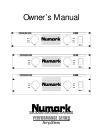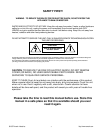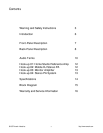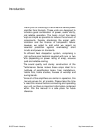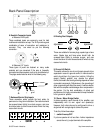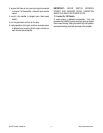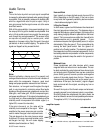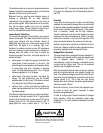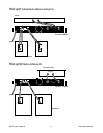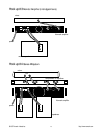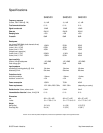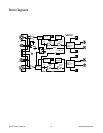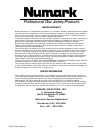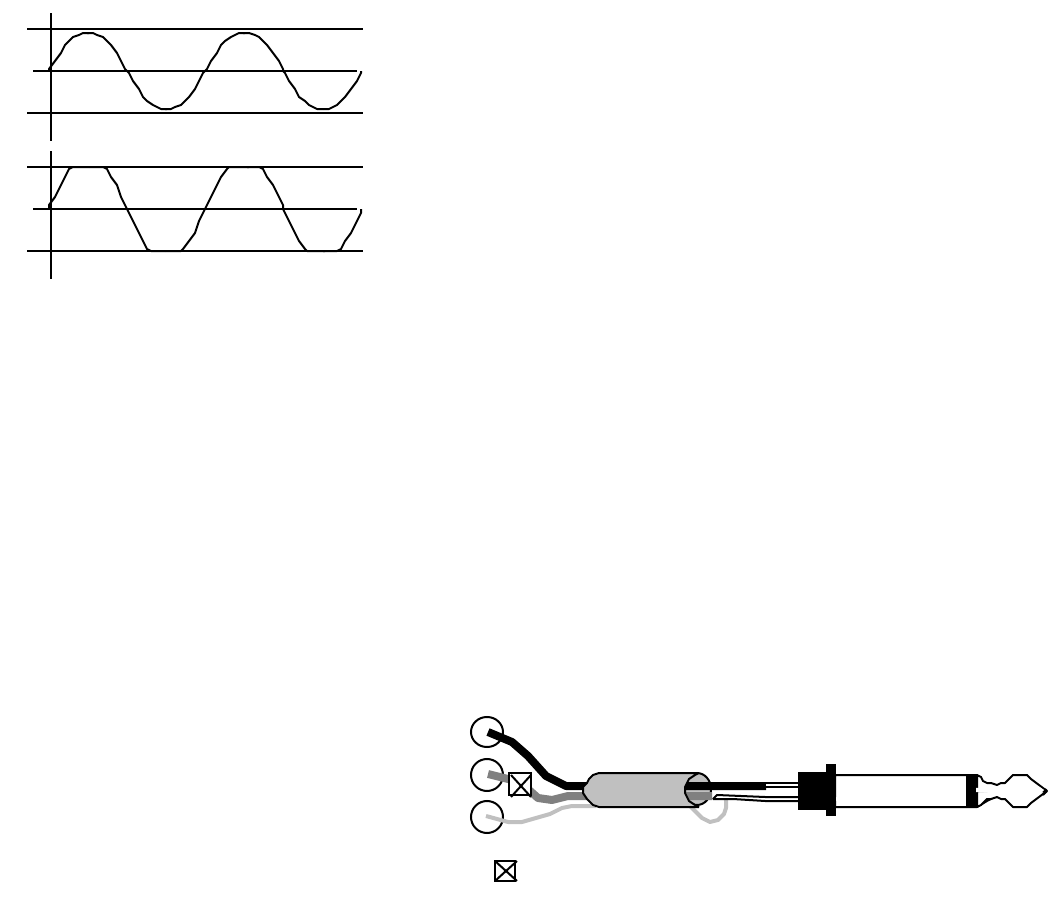
©1997 Numark Industries http://www.numark.com
10
Audio Terms
Gain
This is the factor by which an input signal is amplified
(increased) or attenuated (reduced) when passing through
an amplifier. Gain is generally measured in decibels (dB)
which is a logarithmic ratio of input to output. Unity or
zero gain means that the signal comes out at the same
level that it went in.
With all this gain available, it may seem tempting to turn
the amp up to full to get the loudest sound possible. And
why is it that smaller amps have roughly the same gain
even though they are less powerful? The answer is that
an amp can only amplify up to a certain point, which
depends on its power rating. Past this point, the output
just distorts in what is called clipping. The peaks of the
signal are ‘clipped’ as they exceed the limit.
max+
max-
max+
max-
#1. Peaks within amplifier limit
#2.Too much gain, distorted sound
Noise
Noise is typified by a hissing sound. It is present in all
analogue electronics due to random thermal vibration of
atoms within the components. However, good circuit
design and proper operation reduces this to a minimum.
Gain structure, i.e. how gain is set throughout the signal
path, is very important in minimizing noise. Most audio
signals go through several gain stages such as input trim,
fader gain, main fader gain, EQ and compressor gain,
and power amplifier gain. If the signal is boosted early on
to a high level, any noise subsequently picked up will be
relatively small in comparison to the audio signal (i.e.
higher S/N, or sound to noise ratio).
If the gain is low early on, the noise will be
relatively loud compared to the signal. When
amplified at the power amp more gain must be
used to make the signal reach required levels.
This gain also acts on the noise, hence a noisier
final sound. Of course, care must be taken not to
set the gain too high, this will cause clipping
distortion (see first section on ‘Gain’).
Hum and Buzz
Hum typically is a lower pitched sound of around 50 or
60Hz, depending on the AC supply. If the hum or buzz
is very loud, this is generally caused by bad connections
- check cables and plugs for faults.
Lifting the Ground
In other cases, a ground conflict between the chassis and
the circuit ground can induce hum. This happens when a
magnetic field induces a small voltage in the casing of the
amp, making it slightly different in potential from the circuit
ground. This hum sounds more subtle than it would be for
a bad connection and is generally ignored. If your
environment requires the highest quality sound, it may be
eliminated by ‘lifting the ground’. This is accomplished by
moving the back panel switch from the ‘ground on’
position to the ‘floating’ position. The electronic ground is
then dependent on other connected components. For the
best safety protection and protection of other components,
it is strongly advised to keep the switch in the ‘ground on’
position.
Balanced Lines
Power transformers and other devices which cause
magnetic fields can induce hum in audio cables. This can
be best combated by using balanced lines where inputs
and outputs permit. Balanced lines use two conductors
plus a shield (ground) to send a positive and negative
version of the audio signal down the line. These are in
close proximity and therefore pick up the same hum or
interference. At the input, the inverted (-) signal is flipped
back and mixed with the original, canceling any hum or
interference.
Since all the inputs of the Numark amps are balanced,
accepting signals from a balanced output is no problem.
Should the output be unbalanced, the cable should be
wired as follows to ensure the best possible performance.
This applies to XLR, 1/4” and barrier strip inputs alike:
+
-
GND
GND
+
Where is a variable resistor, adjustable between 0 and 600 ohms.
amplifier inputs
unbalanced output



